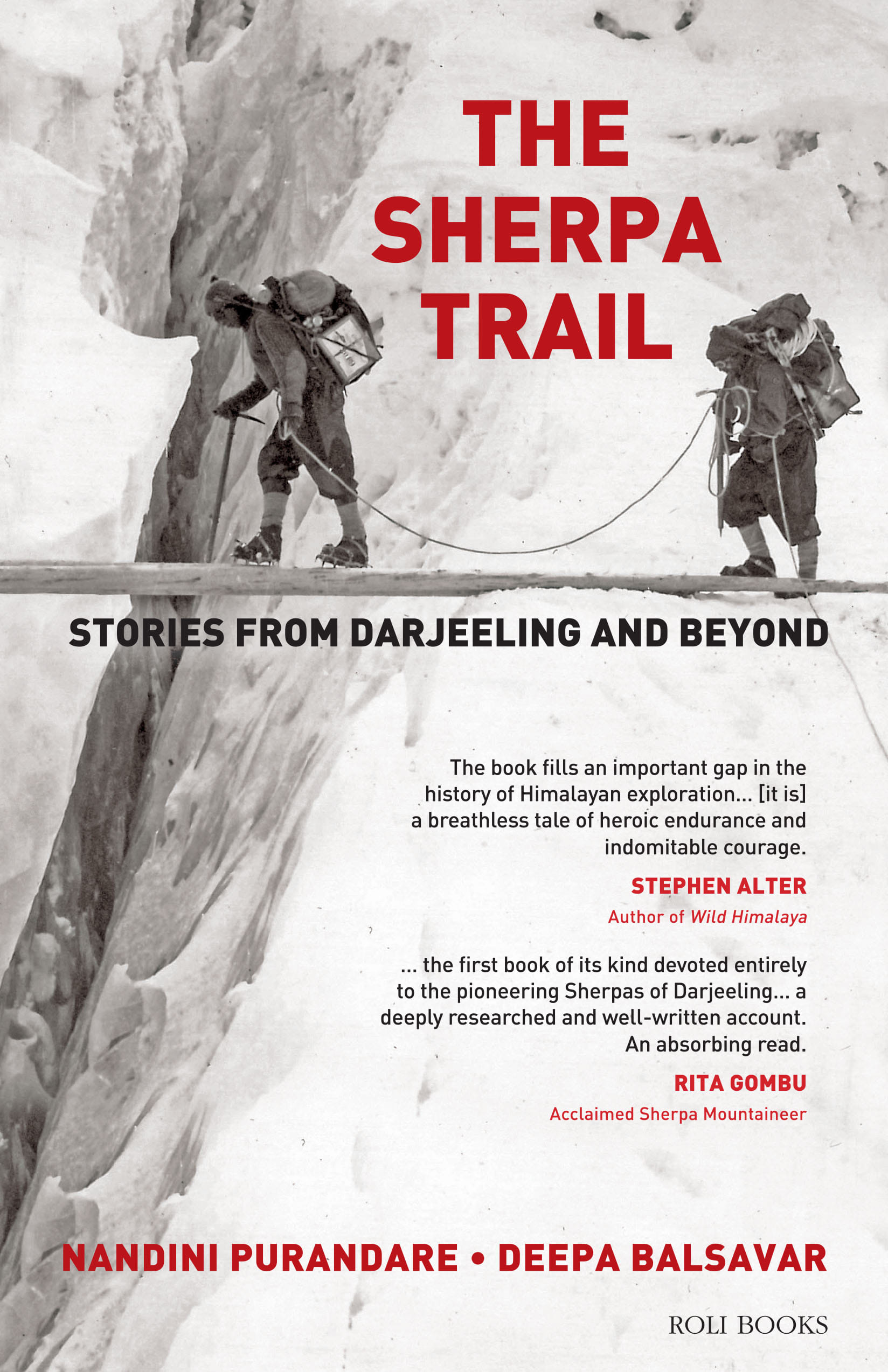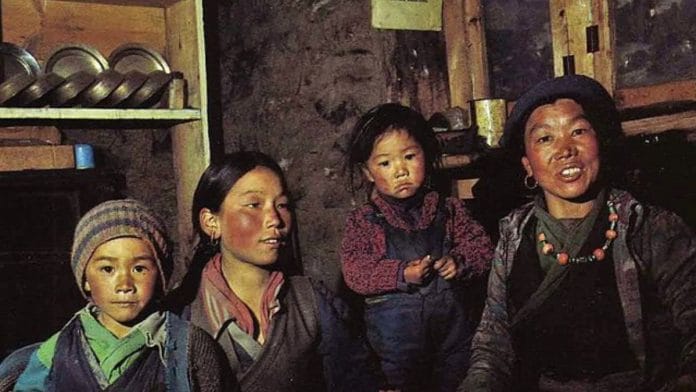THARCHEN, SON OF LEGENDARY CLIMBER Ang Tsering, gave us a lesson in pronunciation during one of our many chats with him. “It’s not ‘Sherpa’; it’s Sheaar-wa. Sheaar means ‘east,’ and wa or pa means ‘people.’ So Sheaarwa or Sheaarpa means ‘people who came from eastern Tibet to Nepal.’ That is where the clan originally came from.”
PemPem, daughter of Tenzing Norgay, offered an explanation based on her own research. Bordering the province of Sichuan in China is a region of Tibet called Kham. “The Sherpas come from the west [portion] of Sichuan and the east [portion] of Kham,” she said. “The origin of Sherpas is from there. Another proof is—do you know Sichuan pepper? We call it ermung. Sherpa people treat ermung like chili. We eat ermung with butter and potato bread. You grate a potato, make a pancake, put butter and Sichuan pepper [on it], and eat. It’s yummy.
“How did the Sherpa bring this pepper? From where? Their ancestors brought it from Sichuan. They used to live there. But their arrival, their movement to the foot of Everest on the Nepal side, has different explanations. Some say there was a war; Ghengis Khan massacred people, and so people started running away. Some moved north, some east, some west, and some south.
Those who moved southwest crossed Nangpa La”—a 5,790-meter mountain pass between Tibet and Nepal—“and descended into huge green valleys. They thought this is a place for our yaks, for living. History says it was in the early 1500s. This is how the Sherpas spread.”
The region south of the great peaks of Mount Everest, Nuptse, and Ama Dablam is known as Khumbu and is home to a village called Namche, or as the Sherpas say, Nauje Bazaar. This region, according to legend, was the first area in Nepal settled by the ancestors of the current Sherpas.
From here, some families then started migrating south to the valley of the Solu Khola River and to the area separating Khumbu and Solu called Pharak, meaning “difference” or “divide.” When talking about their homes, most Sherpas use the term Solu Khumbu, combining the entire area into one.
The anthropologist Christoph von Fürer-Haimendorf made several visits to the Khumbu region through the 1950s and early 1960s, staying for months at a time in all the main villages and following several groups of families to their high pastures. Nepal before the 1950s was closed to foreigners, so when he traveled there, almost nothing was known to the outside world about the local tribes. In The Sherpas of Nepal, he too wondered about the name “Sherpa.” He writes:
The name Sherpa is derived from the Tibetan word shar-pa, which means “easterner,” but it is not clear in what manner this term came to be associated with this particular group. From the Tibetan point of view Sherpas are southerners rather than easterners, and even within a purely Nepalese setting the term has no real justification for other Bhotia groups dwell to the east as well as the west of the Sherpa country. Yet, the term has gained wide currency and must be accepted as the name of an ethnic group with a pronounced sense of separateness from other Bhotia groups.
Also read: ‘Hillary, Tenzing followed my footsteps’ — Sherpa who paved the way to Everest with 25kg load
Lhatoo explained that the name Bhotia, or Bhutia, “comes from the term Bhot, meaning ‘Tibet.’ For generations, Tibetans have migrated over the high passes and settled all along the lesser Himalayan range, from Ladakh in the west to Arunachal Pradesh in the east—not down in the plains where it is too hot, but up in the highlands where they can graze their cattle, cultivate crops, and make a living.
At first the term Bhutia must have been a casual one to refer to all these people with Mongoloid features who settled on the southern slope of the Himalaya, but gradually it became formal nomenclature, accepted for administrative purposes in the classification of different tribes. In Darjeeling when you say, ‘Bhutia,’ you are of Tibetan stock. Sherpas are also of Tibetan stock. Specifically, they are the Tibetans who migrated to Solu Khumbu in Nepal.”
So Bhutia is a broader term and Sherpa is narrower. All Sherpas are Bhutia, but a Bhutia is not necessarily a Sherpa. How did they come to Solu Khumbu? There is no written history. It’s all theory, and the theories vary.
One theory, Lhatoo told us, was that the Sherpas were a group of clans who fled from a religious churning that took place in Tibet. There are four major schools of Tibetan Buddhism—Nyingma (the oldest), followed by Kagyu, Sakya, and Gelug. Sherpas are mainly Nyingmapas—followers of the Nyingma sect, which combines Hinduism with Buddhism in a form of highly ritualistic practices called Tantra.
Sometime in the 1500s when the other three groups adopted a series of reforms, the Nyingmapas fled their traditional lands and came to Nepal.
Lhatoo explained, “Some also say they were actually nomadic. They moved with their cattle to greener pastures. For them in those days until the Chinese came to Tibet, all these borders were open: Sikkim, Nepal, Tibet, India. Only since my time—I have seen it happen— they quickly put check posts and restricted the crossing of borders. Earlier, these people just came and went.
They came with their cattle as nomads and they found more fodder on this side of the Himalaya. Then they settled there and realized that this is another country and not Tibet, because immediately government people came to collect taxes. It is like my family’s history.”
Dorjee Lhatoo pointed to his face. He smiled and said, “So if you go to Bhutan, Sikkim, China, Arunachal, Ladakh, or Central Asia, you will see people of my face. I am that face.” On another day, Lhatoo’s niece Ongmu told us the same thing: “After all, we are all Genghis Khan’s descendants!” she said with a laugh.
 This excerpt from ‘The Sherpa Trail: Stories from Darjeeling and Beyond’ by Nandini Purandare and Deepa Balsavar has been published with permission from Roli Books.
This excerpt from ‘The Sherpa Trail: Stories from Darjeeling and Beyond’ by Nandini Purandare and Deepa Balsavar has been published with permission from Roli Books.






